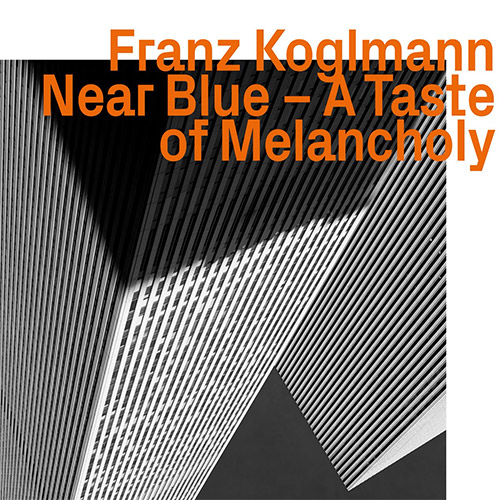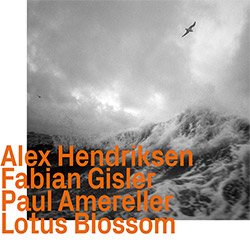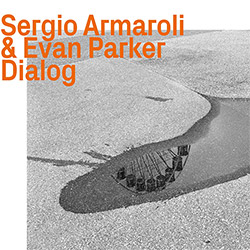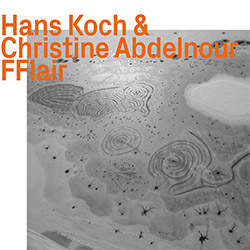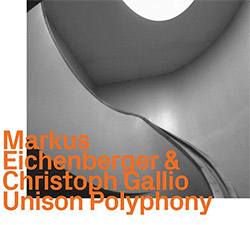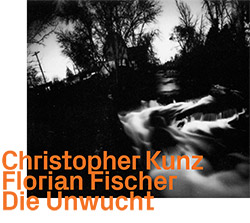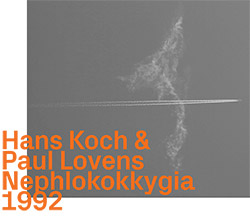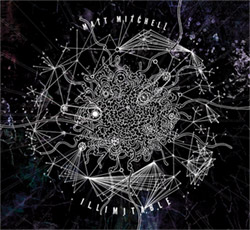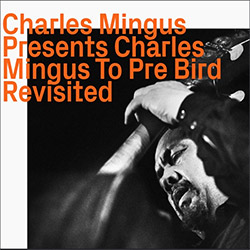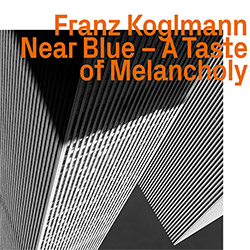
Presented in two versions--a stereo mix and a binaural mix for headphones--flugelhorn improviser and composer Franz Koglmann leads his septet of exceptional players through 10 original Koglmann compositions, sophisticated works that show influences from Ellington to Franz Joseph Haydn or Johann Strauss, in pieces influenced by or tipping the hat to modern artists, musicians and writers.
In Stock
Quantity in Basket: None
Log In to use our Wish List
Shipping Weight: 2.00 units
Sample The Album:
Franz Koglmann-flugelhorn
Gert Schubert-violin
Kurt Franz Schmid-clarinet
Sandro Miori-tenor saxophone, soprano saxophone, alto flute
Rudolf Ruschel-trombone
Raoul Herget-tuba
Robert Michael Weiss-piano
Click an artist name above to see in-stock items for that artist.
UPC: 752156105626
Label: ezz-thetics by Hat Hut Records Ltd
Catalog ID: ezz-thetics 1056
Squidco Product Code: 34504
Format: CD
Condition: New
Released: 2024
Country: Switzerland
Packaging: Cardboard Gatefold
Recorded at Stella Musica Studio Wiener, in Neustadt, Austria, on October 6th, 7th, and 8th, 2023, by Christian Zierhofer.
"When the past and the present - and implicitly the future - comingle in jazz, the listener can become briefly unstuck in time; but unlike Billy Pilgrim in Slaughterhouse Five, who ricochets between the hellscape of firebombed Dresden, the banalities of post-war suburbia, and a pleasure dome in outer space. Rather, it is a glide through associations accrued over years and decades and the particulars of each moment an entry is added to the compendium. A necessarily labyrinthine route that repeatedly crosses itself, it is a historicizing journey, although its resulting history is not, as attributed to Arnold Toynbee, "one damn thing after another," but a whirl of ideas posited decades ago, continually honed, and projected into the future.
Thirty years ago, Art Lange noted that Franz Koglmann understood Duke Ellington as a vortex of diverse sources inspiring a wide variety of works. Time has proven Koglmann to also be such a vortex. For more than a half century, he has taken the crisscrossing path, guided by an unlikely, sprawling constellation of composers and improvisers and writers and visual artists: Ellington and Vladimir Nabokov; Ezra Pound and Chet Baker; Bob Zieff and Rene Magritte; Jean Cocteau and Bill Dixon; George Russell and Yves Klein; and on and on, ever expanding. It is a list that reflects Koglmann's provocative aesthetic, a critique of the standard Americentric jazz narrative that nevertheless honors - and savors - many of its greatest exponents.
The commentariat's consensus that Koglmann's is the aesthetic of cool is close enough for general discussion, even as it glosses over his off-center classicism and impeccably mannered subversions, as well as his extension of thornier Third Stream practices. Viennese cool is closer to the mark, as Koglmann triangulates aspects of Wiener Moderne - the formalism of Arnold Schoenberg and Adolf Loos; the exploration of sexuality by Gustav Klimt and Arthur Schnitzler; Hermann Bahr's "romanticism of the nerves" - with jazz virtues. Koglmann applies the probity associated with Wiener Moderne to both his original works and his interpretations of jazz literature spanning "Ezz-thetics" to "At the Jazz Band Ball" to create music that is far afield from stereotypical cool jazz.
The Viennese component of Koglmann's aesthetic reasserts itself on Near Blue - A Taste of Melancholy, beginning with its title. In an essay comparing mourning and melancholia, Sigmund Freud theorized the latter was the grief for a loss that eludes identification or comprehension, taking place largely in the subconscious. "A taste" suggests melancholy can be experienced like an amuse bouche, something best appreciated by the connoisseur; and "near blue" implies a critical distance, not a full immersion. While this Viennese-tinged dynamic between analysis and sensuality are prominent in album-length works like "Venus in Transit, Let's Make Love: An Imaginary Play in 12 Scenes", and "Lo-lee-ta: Music on Nabokov", it presents differently on this collection.
Near Blue - A Taste of Melancholy is a snapshot of Koglmann unstuck in time, gliding between revamped, decades-old works and first recordings of more recent compositions. Four compositions included on prior recordings have been rescored for trio, quartet, and sextet. In each case, Koglmann transforms the material. Originally a lithe duet with Burkhard Stangl on A White Line, "April in Vienna" becomes a shadow-dappled cityscape in this sextet version; a space-privileging duet with Misha Mengelberg on L'Heure Bleu, the addition of trombone and tuba on "Nachts" pointedly evokes a long, uncertain night.
On "Franz Schuh" and "A Day's Work," Koglmann takes the additional step of restructuring the compositions, bookending the thematic materials with improvisations to give each a distinctly new shape. The latter also benefits from a simple shift in palette, substituting alto flute and piano for the original's guitar and bass. Koglmann's nod to the Viennese cultural critic entailed the overhaul of "Späte Liebe," a setting of four Schuh poems for soprano voice and chamber orchestra included on Don't Play, Just Be. In this trio for soprano saxophone, flugelhorn and piano, Koglmann distills the materials to piquant essences.
Koglmann also continues long-standing compositional practices in works toasting Baker and Zieff. Inspired by a photo of Baker wearing CAT brand shoes in a photograph that ran in a 1965 issue of the French Jazz Magazine, Koglmann used phrases from Baker improvisations as the basis for "Chet's CATS Heels." Zieff's compositions, which Koglmann considers to be pinnacles of extended modern jazz, are echoed on "Waltz for Bob;" not only is Vienna a subtext of the piece because of its meter, but also because Zieff's compositions were recorded by Art Farmer, who resided in Vienna for the last 30 years of his life.
The album ends with a three-part work relating to the work of Julian Schutting. The opening section uses a 12-tone row and its reversals that Koglmann composed for a performance with the Austrian poet, novelist, and essayist, during which Schutting recited a text about his friendship with the serial composer J. M. Hauer, who had dedicated a "Zwölftonspiel" to Schutting. Koglmann had originally intended to use Hauer's tone row for the piece; unable to locate it, Koglmann devised his own. The piece encapsulates the album, as it seesaws between the ponderous and the puckish.
Although Koglmann uses serial techniques and has found inspiration in composers like Franz Joseph Haydn and Johann Strauss the Younger, he remains a jazz composer in the tradition of Ellington on essential counts: decades-long relationships with key players; incisive blending of instrumental colors; and unerringly pairing of soloists and materials. Koglmann's septet mixes old and new colleagues. Rudolf Ruschel and Raoul Herget have been integral to Koglmann's music for forty years; Robert Michael Weiss has contributed to various Koglmann projects for almost as long; and Gert Rainer Schubert first recorded with Koglmann twenty years ago.
The newcomers are Kurt Franz Schmid and Sandro Miori, who supply the warm highlights essential to creating the contrasts with lower-pitched brass that drive Koglmann's charts. They also ably step into the void left by the passing of Tony Coe, delivering concise, engaging solos. Koglmann's deft hand in distributing well-suited solo space to his colleagues is frequently confirmed throughout the album. Given his emphasis on composition and orchestration, Koglmann's own solos are reminders that he is also an impressive improviser. This septet is a worthy successor to Koglmann's Pipetets and Monoblue units; and like Ellington's small groups, it provides insight into the chemistry of Koglmann's art.
Near Blue - A Taste of Melancholy is a soundtrack for being unstuck in time, if just for an hour. It is a glide through a rich past and present, with glimpses of a future worth reaching."-Bill Shoemaker, December 31, 2023

The Squid's Ear!
Artist Biographies
• Show Bio for Franz Koglmann "Austrian trumpeter Franz Koglmann (1947) debuted in the 1970s. Bill Dixon's Opium contained the 17-minute For Franz (august 1976) performed by a quintet with two trumpets (Dixon and Koglmann), tenor saxophone, bass (Alan Silva) and percussion. The rest of the album (recorded between december 1975 and november 1976), contains compositions by Koglmann and features Franz Koglmann on flugelhorn and Steve Lacy on soprano sax except one piece that is an early electronic experiment with Gerd Geier on computer and Toni Michlmayr on bass. Koglmann founded the Chamber Jazz Emsembles Pipetet that debuted with Schlaf Schlemmer Schlaf Magritte (december 1984), a vehicle for his brainy scores that embedded everything from Arnold Schoenberg's dodecaphony to swing to free jazz, all done with a Dadaist attitude worthy of Pere Ubu (notably in the four-movement Tanzmusick Fuer Paszstueckem). Evolving through fragmented albums such as Ich (october 1986), his manyfold art of composition and deconstruction bloomed on the nine-movement suite The Use of Memory (october 1990), almost a colossal compendium of 20th century music. Orte Der Geometrie (november 1988) featured alto saxophonist Guillermo Gregorio, soprano saxophonist Roberto Ottaviano, Jean-Christophe Mastnak on French horn, bassist Klaus Koch, trombonist Rudolf Ruschel, tuba player Raoul Herget, clarinetist Martin Schelling, pianists Ran Blake and Robert Michael Weiss, oboe player Mario Arcari, guitarist Burkhard Stangl, drummer Fritz Hauser, and "conductor" Gustav Bauer. A White Line (november 1989) was a collaboration with an ensemble conducted by Gustav Bauwer: Jean-Christoph Mastnak (flugelhorn), Raoul Herget (tuba), Mario Arcari (oboe), Tony Coe (clarinet and tenor sax), Helmut Federle (accordion), Paul Bley (piano), Burkhard Stangl (guitar), Klaus Koch (bass), and Gerry Hemingway (drums). A theorist not so much of post-modern but of post-classical music, Koglmann continued to rehearse a cryptic vision of music on albums such as L'Heure Bleue (april 1991) only to unleash another massive, powerful reconceptualization of the century's music with Cantos I-IV (october 1992) for orchestrated improvisers. Koglmann had coined a moving music of contradictions, misunderstandings and, ultimately, of mistakes. His monumental and demented synthesis of improvised and composed music continued on O Moon My Pin Up (march 1997), explicitly dedicated to poet Ezra Pound. After Make Believe (november 1998) for a quintet, he also ventured outside chamber music with the electroacoustic opera Fear Death By Water (march 2003) and the "imaginary play" Let's Make Love (september 2004). One of the greatest composers of his generation, Koglmann metabolized the past in order to create the future. Lo-lee-ta (2009) was inspired by Vladimir Nabokov's texts and performed by the Monoblue Quartet (Tony Coe on clarinet/alto saxophone, Ed Renshaw on guitar, Peter Herbert on bass). Join! (Orf, 2014), the first album in five years, is a sci-fi opera, premiered in may 2013, for seven opera singers and a chamber ensemble. G(ood)luck (april 2015) documents a trio with Mario Arcari on English horn and oboe, and Attila Pasztor on cello." ^ Hide Bio for Franz Koglmann • Show Bio for Kurt Franz Schmid Kurt Franz Schmid is an Austrian clarinetist, known for the groups Das Wiener Terzett, Tonkünstler Orchestra, Zemlinsky Quintett Wien. ^ Hide Bio for Kurt Franz Schmid • Show Bio for Sandro Miori "The saxophonist and flautist Sandro Miori was born in Bolzano/Italy in 1961. The first instrument he learned was the flute at the middle school of the Bolzano Conservatory (before that he liked to play the harmonica). In 1985 he moved to Vienna, where he completed pedagogical training for classical saxophone with Prof. Oto Vrhovnik and for jazz saxophone with Martin Fuss with a focus on the transverse flute with Prof. Raphael Leone at the University of Music. As a scholarship holder, he spent a year studying at the Hartford Conservatory (Connecticut/USA) with George Sovak. He took part in numerous master classes, among others. with the saxophonists Steve Lacy, Bob Berg, Lee Konitz, George Garzone, Jerry Bergonzi and with the flautists Robert Dick, Wil Offermans and Bill Holcombe. He played and made some recordings with Reform Art Unit, Sunny Murray, Walter Malli, Peter Gabis, Henrik Hallberg, Yuko Gulda, Wolfgang Reisinger, Franz Koglmann, Walid Rouissi, Lorenzo Frizzera, the Blue Eyes Big Band, the Vienna Improvisers Orchestra and many others. During his stay in the USA he was a member of the New England Jazz Ensemble and performed with the Walt Gwardyak Quartet." ^ Hide Bio for Sandro Miori • Show Bio for Rudolf Ruschel Rudolf Ruschel is an Austrian trombonist, known for the group Franz Koglmann Pipetett, Franz Koglmann Quartett, Pipe Trio, Reform Art Orchestra. ^ Hide Bio for Rudolf Ruschel • Show Bio for Raoul Herget Raoul Herget is an Austrian tubist, born 11 November 1957. He is known for the groups Franz Koglmann Pipetett, Franz Koglmann Quartett, Pipe Trio, Reform Art Orchestra, and Steve Lacy+16. ^ Hide Bio for Raoul Herget • Show Bio for Robert Michael Weiss "Robert Michael Weiß (born August 1, 1956 in Vienna) is an Austrian jazz pianist, harpsichordist and composer. He is considered the leading specialist in Austria for the compositions of Josef Matthias Hauer. Robert Michael Weiß received his first piano lessons at the age of 6. After graduating from the Zirkusgasse Federal High School in 1974, he studied piano, music and instrumental pedagogy at the Vienna University of Music from 1975, and from 1976 jazz piano and harpsichord with Fritz Pauer at the Vienna Conservatory and Josef Matthias Hauer's twelve-tone playing at the Hauer- Student Victor Sokolowski. In 1984 he attended a workshop by George Russell. From the late 1970s onwards, Weiß performed internationally, first in the duo Gemini with Woody Schabata on marimba and vibraphone (Middelheim Jazz Festival, Belgium 1978) and on the first tour of the Vienna Art Orchestra. As a pianist he can be heard on the first Austrian jazz production on CD: Woody Schabata's "May-Rimba". He has been part of Franz Koglmann's "Pipetet" since it was founded in 1983. He also performed in a duo with Lee Konitz, Jim Pepper, Roger Bobo and also with the violinist Ernst Kovacic. In 1988, Weiß was awarded the City of Wiener Neustadt Recognition Prize for Music and Music Education. Weiß was the conductor of the Austrian premiere (2000) of "M is For Man, Music, Mozart" by Louis Andriessen/Peter Greenaway. He formed the dance-music duo "zweiacht" with the dancer Doris M. Reisinger (since 2002). He is the musical director of the jazz big band 11concertBand (CD and tour "Mingus Music", 2007; "Money Jungle", 2008). He also played in a duo with bass trombonist Dave Taylor (Brucknerhaus Linz, Vienna, Passau, 2008). In 1999 he was artist in residence for "musik aktuell - new music in Lower Austria". Weiß also emerged as the author of numerous twelve-tone plays and wrote compositions and improvisation concepts at the interface between jazz and modern concert music. His compositions were played by the "Manhattan Brass Quintet", New York, the Koehne Quartet and the Lower Austrian Tonkunstlerorchester. Until 2010, Weiß was deputy head of the Josef Matthias Hauer Conservatory in the city of Wiener Neustadt, and since 2010 he has been deputy head of the Josef Matthias Hauer Music School." ^ Hide Bio for Robert Michael Weiss
7/10/2024
Have a better biography or biography source? Please Contact Us so that we can update this biography.
7/10/2024
Have a better biography or biography source? Please Contact Us so that we can update this biography.
7/10/2024
Have a better biography or biography source? Please Contact Us so that we can update this biography.
7/10/2024
Have a better biography or biography source? Please Contact Us so that we can update this biography.
7/10/2024
Have a better biography or biography source? Please Contact Us so that we can update this biography.
7/10/2024
Have a better biography or biography source? Please Contact Us so that we can update this biography.
Track Listing:
1. Franz Schuh 05:01
2. Nachts 03:29
3. Chet's CATS Heels 03:14
4. April In Vienna 03:58
5. Near Blue 03:58
6. Waltz For Bob 05:27
7. A Day's Work 05:43
8. Schutting Intro 01:48
9. Schutting Interlude 03:02
10. Schutting Ending 03:18
11. Franz Schuh - Binaural mix 05:01
12. Nachts - Binaural mix 03:29
13. Chet's CATS Heels - Binaural mix 03:14
14. April In Vienna - Binaural mix 03:58
15. Near Blue - Binaural mix 03:58
16. Waltz For Bob - Binaural mix 05:27
17. A Day's Work - Binaural mix 05:43
18. Schutting Intro - Binaural mix 01:48
19. Schutting Interlude - Binaural mix03:02
20. Schutting Ending - Binaural mix 03:12
Hat Art
Improvised Music
Jazz
Melodic and Lyrical Jazz
Septet recordings
Staff Picks & Recommended Items
New in Improvised Music
Recent Releases and Best Sellers
Jazz & Improvisation Based on Compositions
Search for other titles on the label:
ezz-thetics by Hat Hut Records Ltd.

